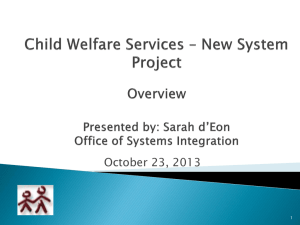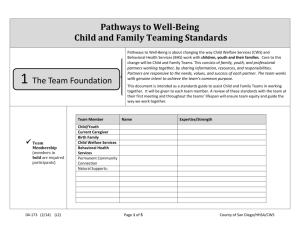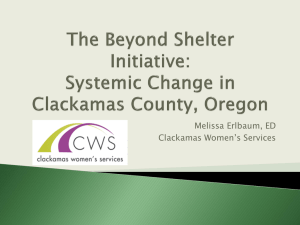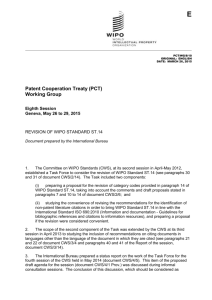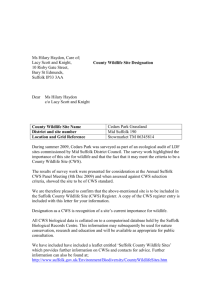evaluation of the college writing seminar - Offices
advertisement
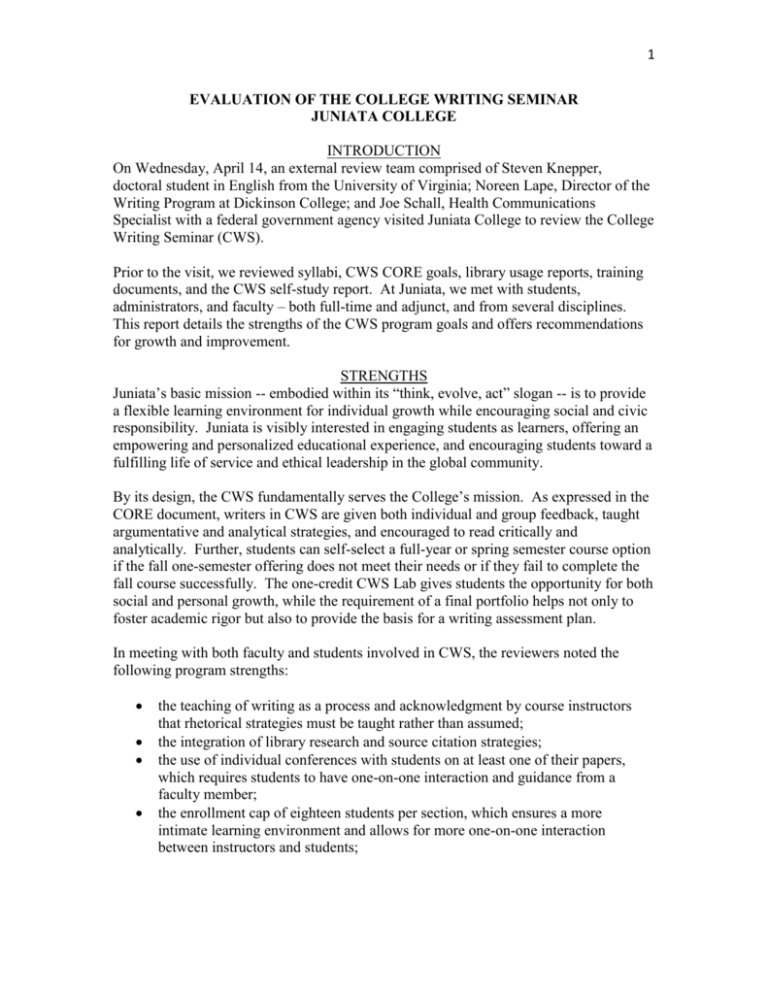
1 EVALUATION OF THE COLLEGE WRITING SEMINAR JUNIATA COLLEGE INTRODUCTION On Wednesday, April 14, an external review team comprised of Steven Knepper, doctoral student in English from the University of Virginia; Noreen Lape, Director of the Writing Program at Dickinson College; and Joe Schall, Health Communications Specialist with a federal government agency visited Juniata College to review the College Writing Seminar (CWS). Prior to the visit, we reviewed syllabi, CWS CORE goals, library usage reports, training documents, and the CWS self-study report. At Juniata, we met with students, administrators, and faculty – both full-time and adjunct, and from several disciplines. This report details the strengths of the CWS program goals and offers recommendations for growth and improvement. STRENGTHS Juniata’s basic mission -- embodied within its “think, evolve, act” slogan -- is to provide a flexible learning environment for individual growth while encouraging social and civic responsibility. Juniata is visibly interested in engaging students as learners, offering an empowering and personalized educational experience, and encouraging students toward a fulfilling life of service and ethical leadership in the global community. By its design, the CWS fundamentally serves the College’s mission. As expressed in the CORE document, writers in CWS are given both individual and group feedback, taught argumentative and analytical strategies, and encouraged to read critically and analytically. Further, students can self-select a full-year or spring semester course option if the fall one-semester offering does not meet their needs or if they fail to complete the fall course successfully. The one-credit CWS Lab gives students the opportunity for both social and personal growth, while the requirement of a final portfolio helps not only to foster academic rigor but also to provide the basis for a writing assessment plan. In meeting with both faculty and students involved in CWS, the reviewers noted the following program strengths: the teaching of writing as a process and acknowledgment by course instructors that rhetorical strategies must be taught rather than assumed; the integration of library research and source citation strategies; the use of individual conferences with students on at least one of their papers, which requires students to have one-on-one interaction and guidance from a faculty member; the enrollment cap of eighteen students per section, which ensures a more intimate learning environment and allows for more one-on-one interaction between instructors and students; 2 the use of both adjunct instructors and instructors from outside of the English Department, which lends more diversity to the teaching pool and offers students more choices and different kinds of potential mentors; the integration of current, timely, and engaging issues into the course curriculum, like “Writings by Recent Pulitzer Prize Winners” and “Peace, War, and Terrorism”; the use of the Hofelt prize for freshman writing, in that programs at many schools do nothing to acknowledge superior writing by first-year students; the opportunity for structured peer networking and connecting with upper-class mentors via the CWS Lab, which students voiced as highly important to their integration into the college community; close interaction between the CWS Lab leaders and the CWS Dean of Students Office, underscoring the principle that, as noted by the Assistant Dean of Students, CWS can be a “bellwether for how things will go for the student at Juniata in general”; the fact that 10-15 students per year receive a failing grade in the class, suggesting that the class involves high standards and that CWS faculty have not bowed to the national trend of grade inflation. RECOMMENDATIONS In light of current trends and developments in writing program administration, we recommend that the CWS Program consider these issues: General Administration The Writing Program would benefit from greater coherence created by a Writing Program Administrator who would oversee CWS, CW, and the Writing Center. The faculty we met were pleased with and enthusiastic about the new CW goals; many felt the old goals were so generalized as to be meaningless. However, it was not clear to us who would be responsible for administering the CW courses and whether there had been meaningful conversation about the connection between the learning goals for CWS and CW courses. A Director of Writing, who served mainly as an administrator with a modest teaching load, could oversee the Writing Program curriculum and develop an assessment plan with the help of an oversight committee comprised of faculty, student lab leaders, and invested administrators. College Writing Seminar Decide whether to model CWS after a First-Year Composition (FYC) or FirstYear Seminar (FYS) model. The CWS curriculum lacks consistency in practice. Some faculty we spoke to described a course that focused almost entirely on writing skills (FYC) while others shaped the course around themes like “The Cultural History of Blues and Jazz” and “Peace, War, and Terrorism” (FYS), presumably with a broader emphasis on critical reading, writing, and academic exchange. When we spoke to students, they said they had no idea that some of the courses had themes. If they had known, they said, they would have chosen 3 more their sections more strategically. Further, an FYS model is more consistent with programs at peer and aspirant colleges. Revisit CWS learning outcomes in order to create more of a balance between instructor autonomy and shared program goals. One area of concern arose from students who complained that the amount of reading and writing varied significantly from course to course. How many essays (or written pages, to be more flexible) should professors assign? This may be only one area in which the program needs to achieve consensus while honoring instructor autonomy in other areas like selection of theme, choice of readings, and creation of assignments. Since administrators told us that the goal is to recruit faculty from other disciplines to teach CWS, work to achieve more faculty buy-in. Faculty from disciplines other than English are reluctant to teach a course in first-year composition that they feel unequipped to teach. While achieving faculty buy-in can be a long and difficult process, there are several ways to move in that direction. As one faculty member told us, “use a carrot and remove any obstacles.” The CWS Program can also o get more faculty involved in designing and interpreting CWS program outcomes; o move toward an FYS model in which they choose their own course content, rather than an FYC model, which is typically seen as the purview of English instructors; o offer remuneration in the form of stipends, release time, and/or credit for the annual reviews. Keeping with the idea of removing obstacles, offer faculty development workshops. Many faculty from disciplines other than English are often uncomfortable teaching the first-year course that introduces students to academic discourse. Significantly, one faculty member from outside of English currently teaching CWS said that his interest in doing so was sparked by a faculty development workshop. Despite the fact that many faculty write to produce their own scholarship, their knowledge of how they write, not to mention how other people learn to write, is tacit. Allow faculty opportunities to develop their skills to teach writing by offering workshops on the nuts and bolts: writing effective assignments, sequencing assignments, facilitating revision, and responding to student writing, to name a few. These workshops could be offered either by current teachers of CWS and/or by faculty from other institutions. Further, use materials that faculty develop as a result of those workshops as practical examples of CWS writing objectives. In other words, what assignments do fellow faculty use to teach argument and analysis, audience and sentence style, etc.? In so doing, broad program goals become anchored to specific examples. CWS Laboratory Component Revisit the relationship between the CWS lab and the CWS seminar. Some professors work closely with their lab instructors, making sure that the lab complements the seminar. Other professors, though, do not seem to work very closely with their lab instructors. In these sections, the lab seems to become more of an extension of the orientation process, rather than one credit of a robust first 4 year writing course. Indeed, from our observations, it appears that very few lab sections are being used for serious writing instruction/reinforcement. Incorporate lab projects into the CWS seminar’s writing and thematic goals for the semester. We heard about sections that integrated lab and seminar, like the “Blues and Jazz” course in which students formed a band, developed promotional material, and organized a concert. Yet it seemed that many other lab projects, especially some of the service-based projects, had only a tenuous relationship to the content of the seminar. This perception was reinforced by conversations with students. As with CWS writing requirements, make lab projects fairly uniform in scope and depth (while maintaining instructor autonomy in regard to content). Many students complained that the lab projects required widely differing levels of time commitment and academic skill. These were probably the most forceful complaints we heard during our review. To paraphrase one student, “Some labs pet puppies at the SPCA; ours wrote a fifteen-page research essay.” We suggest that the CWS faculty develop a clearer set of shared guidelines for the lab project. Revisit the “EO” element in the lab curriculum, preferably through a committee of CWS professors, invested administrators, and student lab leaders. Are the learning objectives for the course relevant—especially in terms of lab and seminar integration? One student in particular praised the CWS lab’s “extended orientation” content and assignments for being relevant to his experiences as a freshman. A few other students, however, said that this material felt a bit redundant. One solution is to make the lab more of a workshop for peer review and targeted writing instruction. One way to deal with the issue of training lab leaders for these tasks would be to require them to take the one-credit peer tutoring course. Another way would be to integrate CWS lab more closely with the writing center, drawing lab leaders from a necessarily expanded pool of writing tutors. Program Assessment Relinquish the attempt to prove value-added to writing skills after a one semester course. If the CWS chooses to conduct value-added assessment, assess the writing skills of students after several semesters. Because writing assessment experts hold that it is not possible to prove value-added in fifteen weeks, the trend in recent years has been toward electronic portfolio assessment. Through electronic portfolios, writing programs can collect student writing samples from each year. Value-added assessment is more valid and reliable (and worth the time and effort) when it compares students’ writing as entering freshmen, rising juniors, and graduating seniors, for example. In addition, this kind of long-range assessment is an important reason to appoint a Director of Writing as described above. (For more information on the use of electronic portfolio assessment at small liberal arts colleges, see the work of Carol Rutz from Carleton College.) We concur with the faculty we spoke to that CLA results are problematic. We were told that the results show that Juniata students appear to be less fluent (that is, they write less) than students at peer institutions. However, faculty also reported that seniors had to be cajoled into taking the test and that they do so 5 reluctantly. Thus, the results probably measure the writing abilities of reluctant writers and as such are not terribly useful. (In fact, at the time this report was being written, there was a discussion on the SLAC/WPA listerv in which several WPAs were reporting the exact same issue with CLA – that is, that their college’s CLA test results were not valid because the writing task was disconnected from the learning goals and motivation of the test-takers who were cajoled to take a test in which they had no investment.) Begin all assessment projects with a research question aimed at program improvement. Then collect the data and use the findings to tweak your program goals. In this sense, both small and large scale assessments are useful. Here are some examples of smaller assessment projects: o How do CWS teachers interpret the “CWS CORE” goals in practice? Collect syllabi, writing assignments, and learning goals. Assess the data and use the information to plan faculty development workshops and/or revise the CWS CORE statement. o To paraphrase the CWS Lab Syllabus, do first-year students learn more about Juniata support systems, become integrated into the college community, and have a “successful first semester” as a result of CWS lab? Create focus groups and ask those questions. Look at first-year student grades versus grades of students before the CWS Lab was in place. Give students a brief final exam that tests their knowledge of Juniata support systems. Use the data to revamp the CWS lab curriculum.
